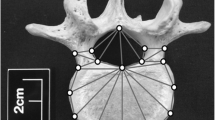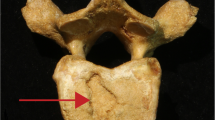Abstract
Background
The attainment of upright posture, with its requisite lumbar lordosis, was a major turning point in human evolution. Nonhuman primates have small lordosis angles, whereas the human spine exhibits distinct lumbar lordosis (30°–80°). We assume the lumbar spine of the pronograde ancestors of modern humans was like those of extant nonhuman primates, but which spinal components changed in the transition from small lordosis angles to large ones is not fully understood.
Questions/Purposes
We wished to determine the relative contribution of vertebral bodies and intervertebral discs to lordosis angles in extant primates and humans.
Methods
We measured the lordosis, intervertebral disc, and vertebral body angles of 100 modern humans (orthograde primates) and 56 macaques (pronograde primates) on lateral radiographs of the lumbar spine (humans–standing, macaques–side-lying).
Results
The humans exhibited larger lordosis angles (51°) and vertebral body wedging (5°) than did the macaques (15° and −25°, respectively). The differences in wedging of the intervertebral discs, however, were much less pronounced (46° versus 40°).
Conclusions
These observations suggest the transition from pronograde to orthograde posture (ie, the lordosis angle) resulted mainly from an increase in vertebral body wedging and only in small part from the increase in wedging of the intervertebral discs.




Similar content being viewed by others
References
Abitbol MM. Lateral view of Australopithecus afarensis: primitive aspects of bipedal positional behavior in the earliest hominids. J Hum Evol. 1995;28:211–229.
Alini M, Eisenstein SM, Ito K, Little C, Kettler AA, Masuda K, Melrose J, Ralphs J, Stokes I, Wilke HJ. Are animal models useful for studying human disc disorders/degeneration? Eur Spine J. 2008;17:2–19.
Alexander LA, Hancock E, Agouris I, Smith FW, MacSween A. The response of the nucleous pulposus of the lumbar intervertebral discs to functionally loaded positions. Spine (Phila PA 1976). 2007;32:1508–1512.
Andreasen ML, Langhoff L, Jensen TS, Albert HB. Reproduction of the lumbar lordosis: a comparison of standing radiographs versus supine magnetic resonance imaging obtained with straightened lower extremities. J Manipulative Physiol Ther. 2007;30:26–30.
Been E, Pessah H, Been L, Tawil A, Peleg S. New method for predicting the lumbar lordosis angle in skeletal material. Anat Rec (Hoboken). 2007;290:1568–1573.
Campana S, de Guise JA, Rillardon L, Mitton D, Skalli W. Lumbar intervertebral disc mobility: effect of disc degradation and of geometry. Eur J Orthop Surg Traumatol. 2007;17:533–541.
Cant JG. Positional behavior of long-tailed macaques (Macaca fascicularis) in northern Sumatra. Am J Phys Anthropol. 1988;76:29–37.
Chen YL. Geometric measurements of the lumbar spine in Chinese men during trunk flexion. Spine (Phila PA 1976). 1999;24:666–669.
Chernukha KV, Daffner RH, Reigel DH. Lumbar lordosis measurement: a new method versus Cobb technique. Spine (Phila PA 1976). 1998;23:74–79; discussion 79–80.
Colman RJ, Kemnitz JW, Lane MA, Abbott DH, Binkley N. Skeletal effects of aging and menopausal status in female rhesus macaques. J Clin Endocrinol Metab. 1999;84:4144–4148.
Colman RJ, Lane MA, Binkley N, Wegner FH, Kemnitz JW. Skeletal effects of aging in male rhesus monkeys. Bone. 1999;24:17–23.
Colombini A, Lombardi G, Corsi MM, Banfi G. Pathophysiology of the human intervertebral disc. Int J Biochem Cell Biol. 2008;40:837–842.
Cunningham DJ. The lumbar curve in man and apes. Nature. 1886;33:378–379.
DeRousseau CJ. Osteoarthritis in rhesus monkeys and gibbons: a locomotor model of joint degeneration. Contrib Primatol. 1988;25:1–145.
Edmondston SJ, Song S, Bricknell RV, Davies PA, Fersum K, Humphries P, Wickenden D, Singer KP. MRI evaluation of lumbar spine flexion and extension in asymptomatic individuals. Man Ther. 2000;5:158–164.
Farfan HF. Form and function of the musculoskeletal system as revealed by mathematical analysis of the lumbar spine: an essay. Spine (Phila PA 1976). 1995;20:1462–1474.
Fennel AJ, Jones AP, Hukins DW. Migration of the nucleous pulposus within the intervertebral disc during flexion and extension of the spine. Spine (Phila PA 1976). 1996;21:2753–2757.
Gal J. Mammalian spinal biomechanics: postural support in seated macaques. J Exp Biol. 2002;205:1703–1707.
Gal JM. Mammalian spinal biomechanics: I. Static and dynamic mechanical properties of intact intervertebral joints. J Exp Biol. 1993;174:247–280.
Garges KJ, Nourbakhsh A, Morris R, Yang J, Mody M, Patterson R. A comparison of the torsional stiffness of the lumbar spine in flexion and extension. J Manipulative Physiol Ther. 2008;31:563–569.
Gebo DL. Climbing, brachiation, and terrestrial quadrupedalism: historical precursors of hominid bipedalism. Am J Phys Anthropol. 1996;101:55–92.
Gracovetsky SA, Iacono S. Energy transfers in the spinal engine. J Biomed Eng. 1987;9:99–114.
Haeusler M, Martelli SA, Boeni T. Vertebrae numbers of the early hominid lumbar spine. J Hum Evol. 2002;43:621–643.
Harrison DE, Harrison DD, Cailliet R, Janik TJ, Holland B. Radiographic analysis of lumbar lordosis: centroid, Cobb, TRALL, and Harrison posterior tangent methods. Spine (Phila PA 1976). 2001;26:E235–E242.
Hayama S. [Spinal compensatory curvature found in Japanese macaques trained for the acquisition of bipedalism] [in Japanese]. Growth. 1986;25:161–178.
Hayama S, Nakatsukasa M, Kunimatsu Y. Monkey performance: the development of bipedalism in trained Japanese monkeys. Kaibogaku Zasshi. 1992;67:169–185.
Hirasaki E, Ogihara N, Hamada Y, Kumakura H, Nakatsukasa M. Do highly trained monkeys walk like humans? A kinematic study of bipedal locomotion in bipedally trained Japanese macaques. J Hum Evol. 2004;46:739–750.
Iwamoto M. Bipedalism of Japanese monkeys and carrying models of hominization. In: Kondo S, ed. Primate Morphophysiology Locomotor Analyses and Human Bipedalism. Tokyo, Japan: University of Tokyo Press; 1985:59–79.
Kimura S, Steinbach GC, Watenpaugh DE, Hargens AR. Lumbar spine disc height and curvature responses to an axial load generated by a compression device compatible with magnetic resonance imaging. Spine (Phila PA 1976). 2001;26:2596–2600.
Korovessis P, Dimas A, Iliopoulos P, Lambiris E. Correlative analysis of lateral vertebral radiographic variables and medical outcomes study short-form healthy survey: a comparative study in asymptomatic volunteers versus patients with low back pain. J Spinal Disord Tech. 2002;15:384–390.
Kramer PA, Newell-Morris LL, Simkin PA. Spinal degenerative disk disease (DDD) in female macaque monkeys: epidemiology and comparison with women. J Orthop Res. 2002;20:399–408.
Latimer B, Ward CV. The thoracic and lumbar vertebrae. In: Leakey RE, Walker A, eds. The Nariokotome Homo Erectus Skeleton. Cambridge, MA: Harvard University; 1993:266–293.
Li Y, Crompton RH, Gunther M, Wang W, Savage R. Reconstructing the mechanics of quadrupedalism in an extinct hominoid. Z Morphol Anthropol. 2002;83:265–274.
Murrie VL, Wilson H, Hollingworth W, Antoun NM, Dixon AK. Supportive cushions produce no practical reduction in lumbar lordosis. Br J Radiol. 2002;75:536–538.
Nakatsukasa M. Acquisition of bipedalism: the Miocene hominoid record and modern analogues for bipedal protohominids. J Anat. 2004;204:385–402.
Nakatsukasa M. Comparative study of Moroto vertebral specimens. J Hum Evol. 2008;55:581–588.
Nakatsukasa M, Hayama S, Preuschoft H. Postcranial skeleton of a macaque trained for bipedal standing and walking and implications for functional adaptation. Folia Primatol (Basel). 1995;64:1–29.
Natarajan RN, Andersson GB. The influence of lumbar disc height and cross-sectional area on the mechanical response of the disc to physiologic loading. Spine (Phila PA 1976). 1999;24;1873–1881.
Ng JK, Kippers V, Richardson CA, Parnianpour M. Range of motion and lordosis of the lumbar spine: reliability of measurement and normative values. Spine (Phila PA 1976). 2001;26:53–60.
Nuckley DJ, Kramer PA, Del Rosario A, Fabro N, Baran S, Ching RP. Intervertebral disc degeneration in a naturally occurring primate model: radiographic and biomechanical evidence. J Orthop Res. 2008;26:1283–1288.
Pickford M, Senut B, Gommery D, Treil J. Bipedalism in Orrorin tugenenesis revealed by its femora. Comptes Rendus Palevol. 2002;1:191–203.
Preuschoft H. Mechanisms for the acquisition of habitual bipedality: are there biomechanical reasons for the acquisition of upright bipedal posture? J Anat. 2004;204:363–384.
Preuschoft H, Hayama S, Gunther MM. Curvature of the lumbar spine as a consequence of mechanical necessities in Japanese macaques trained for bipedalism. Folia Primatol (Basel). 1988;50:42–58.
Roussouly P, Gollogy S, Berthonnaud E, Dimnet J. Classification of normal variation in the sagittal alignment of the human lumbar spine and pelvis in the standing position. Spine (Phila PA 1976). 2005;30:346–353.
Sanders WJ. Comparative morphometric study of the australopithecine vertebral series Stw-H8/H41. J Hum Evol. 1998;34:249–302.
Schultz AH. Vertebral column and thorax. In: Hofer H, Schultz AH, Stark D, eds. Primatologia 4. Basel, Switzerland: Karger; 1961:1–46.
Setton LA, Chen J. Mechanobiology of the intervertebral disc and relevance to disc degeneration. J Bone Joint Surg Am. 2006;88 (suppl 2):52–57.
Shapiro L. Functional morphology of the vertebral column in primates. In: Gebo D, ed. Postcranial Adaptation in Nonhuman Primates. DeKalb, IL: Northern Illinois University Press; 1993:121–149.
Shi C, Nakatsukasa M, Hayama S. Morphological comparison of the vertebral bodies in bipedally trained Japanese macaques. Anthropological Science. 2000;108:96.
Urban JP, Winlove CP. Pathophysiology of the intervertebral disc and the challenges for MRI. J Magn Reson Imaging. 2007;25:419–432.
Van Herp G, Rowe P, Salter P, Paul JP. Three dimensional lumbar spinal kinematics: a study of range of movement in 100 healthy subjects aged 20 to 60+ years. Rheumatology (Oxford). 2000;39:1337–1340.
Vaz G, Roussouly P, Berthonnaud E, Dimnet J. Sagittal morphology and equilibrium of pelvis and spine. Eur Spine J. 2002;11:80–87.
Vialle R, Levassor N, Rillardon L, Templier A, Skalli W, Guigui P. Radiographic analysis of the sagittal alignment and balance of the spine in asymptomatic subjects. J Bone Joint Surg Am. 2005;87:260–267.
Vrtovec T, Pernus F, Likar B. A review of methods for quantitative evaluation of spinal curvature. Eur Spine J. 2009;18:593–607.
Whitcome KK, Shapiro LJ, Lieberman DE. Fetal load and the evolution of lumbar lordosis in bipedal hominins. Nature. 2007;450:1075–1078.
Acknowledgments
We thank Dr Nili Avni-Magen, Biblical Zoo, Jerusalem; Dr Itzhak Aizenberg, Bet Dagan Veterinary Hospital; and Dr Yigal Horovits, Ramat-Gan Safari, for enabling us to study radiologic material in their care. Special thanks to Professor Yoel Rak, Hayuta Pessah, and Sharon Kessler for their useful comments.
Author information
Authors and Affiliations
Corresponding author
Additional information
Each author certifies that he or she has no commercial associations (eg, consultancies, stock ownership, equity interest, patent/licensing arrangements, etc) that might pose a conflict of interest in connection with the submitted article.
Each author certifies that his or her institution has approved the human protocol for this investigation, that all investigations were conducted in conformity with ethical principles of research, and that informed consent for participation in the study was obtained.
This work was performed at Tel Aviv University, Tel Aviv, Israel.
About this article
Cite this article
Been, E., Barash, A., Marom, A. et al. Vertebral Bodies or Discs: Which Contributes More to Human-like Lumbar Lordosis?. Clin Orthop Relat Res 468, 1822–1829 (2010). https://doi.org/10.1007/s11999-009-1153-7
Received:
Accepted:
Published:
Issue Date:
DOI: https://doi.org/10.1007/s11999-009-1153-7




